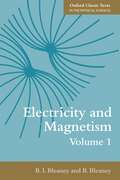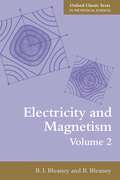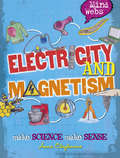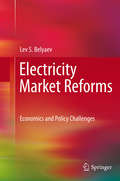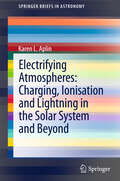- Table View
- List View
Electricity and Electronics for Renewable Energy Technology: An Introduction (Power Electronics and Applications Series)
by Ahmad HemamiElectricity and Electronics for Renewable Energy Technology: An Introduction provides a foundational understanding of electricity and the methods and devices specific to electricity from renewable sources. The book begins with a brief explanation of the necessary mathematics and then: Addresses the basics of electricity and relationships, motors and generators, transformers, and networks and distribution Tackles the key concepts associated with electronics, diodes and transistors, switching devices, and power converters Covers digital electronics from number systems and logic circuits to encoders and decoders Explores advanced subjects such as reactive power and the operation of a transistor A lab manual and PowerPoint presentation are available with qualifying course adoption. Featuring extensive review questions and practice problems at the end of each chapter, Electricity and Electronics for Renewable Energy Technology: An Introduction instills an essential knowledge of electricity and electronics required for work with renewable energy.
Electricity and Magnetism (Student Physics Series)
by E. R. DobbsElectromagnetism is basic to our understanding of the properties of matter and yet is often regarded as a difficult part of an under graduate physics course. In this book answers are developed from first principles to such questions as: What is electricity? What is electromagnetism? Why are some materials magnetic and others non-magnetic? What is magnetism? Physics answers these questions in two related ways. On the one hand the classical explanation is in terms of classical concepts: electric charge q, electric and magnetic fields (E and B) and electric currents. On the other hand the microscopic (or 'atomic ') explanation is in terms of quantum concepts: electrons, nuclei, electron orbits in atoms, electron spin and photons. Microscopic explanations underlie classical ones, but do not deny them. The great triumphs of classical physics are mechanics, gravitation, thermodynamics, electromagnetism and relativity. Historically they began at the time of Newton (seventeenth century) and were completed by Maxwell (nineteenth century) and Einstein (early twentieth century). Microscopic explanations began with J J. Thomson's discovery of the electron in 1897. For most physical phenomena it is best to seek a classical explanation first, especially phenomena at room temperature, or low energy, when quantum effects are small. Although this text is primarily concerned with classical explanations in a logical, self-consistent sequence, they are related to microscopic (quantum) explanations at each stage.
Electricity and Magnetism
by P.F. KellyThe final volume in a three-part series, Electricity and Magnetism provides a detailed exposition of classical electric and magnetic fields and analyses of linear electric circuits. The book applies the principles of classical mechanics to systematically reveal the laws governing observed electric and magnetic phenomena. The text culminates in Maxw
Electricity and Magnetism: New Formulation by Introduction of Superconductivity (Undergraduate Lecture Notes in Physics)
by Teruo MatsushitaThe author introduces the concept that superconductivity can establish a perfect formalism of electricity and magnetism. The correspondence of electric materials that exhibit perfect electrostatic shielding (E=0) in the static condition and superconductors that show perfect diamagnetism (B=0) is given to help readers understand the relationship between electricity and magnetism. Another helpful aspect with the introduction of the superconductivity feature perfect diamagnetism is that the correspondence in the development of the expression of magnetic energy and electric energy is clearly shown. Additionally, the basic mathematical operation and proofs are shown in an appendix, and there is full use of examples and exercises in each chapter with thorough answers.
Electricity and Magnetism: New Formulation by Introduction of Superconductivity (Undergraduate Lecture Notes in Physics)
by Teruo MatsushitaThis book is a very comprehensive textbook covering in great depth all the electricity and magnetism. The 2nd edition includes new and revised figures and exercises in many of the chapters, and the number of problems and exercises for the student is increased.In the 1st edition, emphasis much was made of superconductivity, and this methodology will be continued in the new edition by strengthening of the E-B analogy. Many of the new exercises and problems are associated with the E-B analogy, which enables those teaching from the book to select suitable teaching methods depending on the student’s ability and courses taken, whether physics, astrophysics, or engineering.Changes in the chapters include a detailed discussion of the equivector-potential surface and its correspondence between electricity and magnetism. The shortcomings of using the magnetic scalar potential are also explained. The zero resistivity in a magnetic material showing perfect diamagnetism can be easily proved.This textbook is an ideal text for students, who are competent in calculus and are taking physics, astrophysics, or engineering at degree level. It is also useful as a reference book for the professional scientist.
Electricity and Magnetism in Biology and Medicine
by Ferdinando BersaniThis book, a selection of the papers presented at the 2nd World Congress for Electricity and Magnetism, provides state-of-the-art information on applications of electricity and electromagnetic fields on living organisms, especially man.
Electricity and Magnetism, Volume 1 (Oxford Classic Texts in the Physical Sciences)
by B. I. Bleaney B. BleaneyThis book is a reissue of the third and last edition of a classic text providing the reader with a comprehensive account at first degree or introductory graduate level of the principles and experimental aspects of electricity and magnetism, together with an elementary account of the underlying atomic theory. The book is available in a two-volume format. This first volume contains what is needed for a first course in electromagnetism, including electrostatics, electric circuits, magnetism, electromagnetic induction, and electromagnetic waves. SI units are used throughout and there are problems at the end of each chapter.
Electricity and Magnetism, Volume 2 (Oxford Classic Texts in the Physical Sciences)
by BI Bleaney B BleaneyThis book is a reissue of the third and last edition of a classic text providing the reader with a comprehensive account at first degree or introductory graduate level of the principles and experimental aspects of electricity and magnetism, together with an elementary account of the underlying atomic theory. The book is available in a two-volume format. This second volume includes coverage of electrical and magnetic properties of matter, dielectrics, conduction in metals, magnetic materials, semiconductors and their applications in electronics, superconductors, electronic devices and circuits, magnetic resonance. SI units are used throughout and there are problems at the end of each chapter.
Electricity and Magnets: Electricity And Magnets (PDF) (Mind Webs #3)
by Anna ClaybourneMind Webs is an inspiring, visually exciting, series which will make science make sense. A mind web is a way of putting all of the key information about a topic on one page. Each book contains 12 mind webs, each beautifully illustrated with pictures and diagrams, showing how the information about each topic links together in a truly fascinating way. Whether you want to gain a better understanding of science, or whether you need to revise a topic, these books will give you the full picture, helping you to sort out, learn and remember key science concepts, facts and ideas. Includes advice on how to make your own mind web and a full glossary to extend your scientific vocabulary.
Electricity-based Fuels (SpringerBriefs in Applied Sciences and Technology)
by Alexander TremelThis book discusses the needs of future energy systems with a focus on the electricity and transportation sectors. The general idea behind electricity based fuel is explained, the current status and future potential developments of this technology are presented. A main challenge in the production of electricity based fuels is the fluctuating energy input from renewable electricity generation. The arising design and optimization targets for integrated power-to-fuel plants are discussed, also presenting plant design and operation strategies. The book gives an outlook on future expected production costs of electricity based fuels and compares it with fossil fuels and alternatives.
Electricity from Sunlight: Photovoltaic-Systems Integration and Sustainability
by Vasilis M. Fthenakis Paul A. LynnPraised for its visual appeal, conversational style and clear explanation of complex ideas with minimal mathematics, Electricity from Sunlight has been thoroughly revised and updated to reflect advances in the global PV market, economics and installed capacity. Key features of the 2nd edition include: A timely update of the advances of photovoltaics (PV), with major new material on grid-connected systems. More in-depth treatment of PV scientific principles, solar cells, modules, and systems. Up-to-date coverage of the PV market including conversion efficiencies and the expansion of grid-friendly power plants. End-of-chapter problems with solutions manual available to instructors via companion website. Additional end-of-chapter questions and answers to support students through guided self-study. New chapters on manufacturing processes and on materials and other resources availability. New large-scale PV section covering the growth of global capacity, utility-scale PV and affordable solutions for intermittency. Systems analysis of new applications empowered by low-cost PV, such as energy storage and water desalination. Significantly expanded economics and environmental section explaining leveled cost of electricity versus upfront costs, energy return on investments, and lifecycle analysis. Electricity from Sunlight: Photovoltaics Systems Integration and Sustainability, Second Edition is an essential primer for new entrants to the PV industry, needing a basic appreciation of complete PV systems, and to students on undergraduate and graduate courses on renewable energy and photovoltaics. It also offers a unique treatise of the sustainability of emerging transformative technologies, which makes it useful to both system analysts and energy policy strategists. Co-author, Vasilis Fthenakis, is Recipient of the 2018 William R. Cherry Award The Cherry Award recognizes an individual engineer or scientist who has made a significant contribution to the advancement of the science and technology of photovoltaic energy conversion, with dissemination by substantial publications and presentations. Fthenakis was honored for his pioneering research at the interface of energy and the environment that catalyzed photovoltaic technology advancement and deployment world-wide.
Electricity from Sunlight: Photovoltaic-Systems Integration and Sustainability
by Vasilis M. Fthenakis Paul A. LynnPraised for its visual appeal, conversational style and clear explanation of complex ideas with minimal mathematics, Electricity from Sunlight has been thoroughly revised and updated to reflect advances in the global PV market, economics and installed capacity. Key features of the 2nd edition include: A timely update of the advances of photovoltaics (PV), with major new material on grid-connected systems. More in-depth treatment of PV scientific principles, solar cells, modules, and systems. Up-to-date coverage of the PV market including conversion efficiencies and the expansion of grid-friendly power plants. End-of-chapter problems with solutions manual available to instructors via companion website. Additional end-of-chapter questions and answers to support students through guided self-study. New chapters on manufacturing processes and on materials and other resources availability. New large-scale PV section covering the growth of global capacity, utility-scale PV and affordable solutions for intermittency. Systems analysis of new applications empowered by low-cost PV, such as energy storage and water desalination. Significantly expanded economics and environmental section explaining leveled cost of electricity versus upfront costs, energy return on investments, and lifecycle analysis. Electricity from Sunlight: Photovoltaics Systems Integration and Sustainability, Second Edition is an essential primer for new entrants to the PV industry, needing a basic appreciation of complete PV systems, and to students on undergraduate and graduate courses on renewable energy and photovoltaics. It also offers a unique treatise of the sustainability of emerging transformative technologies, which makes it useful to both system analysts and energy policy strategists. Co-author, Vasilis Fthenakis, is Recipient of the 2018 William R. Cherry Award The Cherry Award recognizes an individual engineer or scientist who has made a significant contribution to the advancement of the science and technology of photovoltaic energy conversion, with dissemination by substantial publications and presentations. Fthenakis was honored for his pioneering research at the interface of energy and the environment that catalyzed photovoltaic technology advancement and deployment world-wide.
Electricity Market Reforms: Economics and Policy Challenges
by Lev S. BelyaevWith the global demand for energy skyrocketing, over the past twenty years many countries have restructured their electric power industries, typically moving from a regulated monopoly to a competitive market structure. The results of these reforms vary significantly from country to country depending on the market organization model and national conditions. This book examines the restructuring in both developed and developing nations, with particular focus on the United States, Great Britain, China, and Russia, and addresses the problems arising from these transitions. The book also contains a comprehensive analysis of different electricity market models and their compatibility with the properties of electric power systems and country conditions. As the most thorough and up to date analysis of the theory and practical experience of electricity deregulation, this book is a must-read for academics, students and researchers with an interest in electric power industry restructuring. It also has direct relevance for engineers, regulators and other decision makers in companies and governmental agencies concerned with energy issues.
Electricity Markets: Theories and Applications (IEEE Press Series on Power Engineering)
by Jeremy Lin Fernando H. MagnagoA comprehensive resource that provides the basic concepts of electric power systems, microeconomics, and optimization techniques Electricity Markets: Theories and Applications offers students and practitioners a clear understanding of the fundamental concepts of the economic theories, particularly microeconomic theories, as well as information on some advanced optimization methods of electricity markets. The authors—noted experts in the field—cover the basic drivers for the transformation of the electricity industry in both the United States and around the world and discuss the fundamentals of power system operation, electricity market design and structures, and electricity market operations. The text also explores advanced topics of power system operations and electricity market design and structure including zonal versus nodal pricing, market performance and market power issues, transmission pricing, and the emerging problems electricity markets face in smart grid and micro-grid environments. The authors also examine system planning under the context of electricity market regime. They explain the new ways to solve problems with the tremendous amount of economic data related to power systems that is now available. This important resource: Introduces fundamental economic concepts necessary to understand the operations and functions of electricity markets Presents basic characteristics of power systems and physical laws governing operation Includes mathematical optimization methods related to electricity markets and their applications to practical market clearing issues Electricity Markets: Theories and Applications is an authoritative text that explores the basic concepts of the economic theories and key information on advanced optimization methods of electricity markets.
Electricity Markets: Theories and Applications (IEEE Press Series on Power Engineering)
by Jeremy Lin Fernando H. MagnagoA comprehensive resource that provides the basic concepts of electric power systems, microeconomics, and optimization techniques Electricity Markets: Theories and Applications offers students and practitioners a clear understanding of the fundamental concepts of the economic theories, particularly microeconomic theories, as well as information on some advanced optimization methods of electricity markets. The authors—noted experts in the field—cover the basic drivers for the transformation of the electricity industry in both the United States and around the world and discuss the fundamentals of power system operation, electricity market design and structures, and electricity market operations. The text also explores advanced topics of power system operations and electricity market design and structure including zonal versus nodal pricing, market performance and market power issues, transmission pricing, and the emerging problems electricity markets face in smart grid and micro-grid environments. The authors also examine system planning under the context of electricity market regime. They explain the new ways to solve problems with the tremendous amount of economic data related to power systems that is now available. This important resource: Introduces fundamental economic concepts necessary to understand the operations and functions of electricity markets Presents basic characteristics of power systems and physical laws governing operation Includes mathematical optimization methods related to electricity markets and their applications to practical market clearing issues Electricity Markets: Theories and Applications is an authoritative text that explores the basic concepts of the economic theories and key information on advanced optimization methods of electricity markets.
Electricity Markets and Power System Economics
by Deqiang Gan Donghan Feng Jun XieAfter the first power plant in history was commissioned for commercial operation by Thomas Edison on Pearl Street in New York in 1882, electricity was sold as a consumer product at market prices. After a period of rapid development, electricity had become such a fundamental product that regulation was believed to be necessary. Since then, the power
Electricity Production from Renewable Energies
by Benoît Robyns Arnaud Davigny Bruno François Antoine Henneton Jonathan SprootenSince the early 2000s, energy and environmental issues have led to a marked increase in electricity production from renewable energy sources. Sustainable development and concern for future generations constantly challenge us to develop new technologies for energy production, as well as new energy usage patterns. Their rapid emergence can make these new technologies difficult to understand and can thus affect perceptions.Directed towards a broad audience, this book contributes to a better understanding of new electricity generation technologies. It presents the issues, sources and means of conversion using a general approach, while developing scientific concepts to understand their main technical characteristics.This revised and extended second edition presents current data characterizing the development of these renewable energy sources, covering emerging photovoltaic and tidal technologies, offshore wind power, and recent developments on the integration of these sources into the electricity grid. The emergence of self-production and self-consumption is also addressed. In addition, several exercises provide the reader with an opportunity to evaluate their understanding.
Electricity Production from Renewable Energies
by Jonathan Sprooten Benoît Robyns Arnaud Davigny Bruno François Antoine HennetonSince the early 2000s, energy and environmental issues have led to a marked increase in electricity production from renewable energy sources. Sustainable development and concern for future generations constantly challenge us to develop new technologies for energy production, as well as new energy usage patterns. Their rapid emergence can make these new technologies difficult to understand and can thus affect perceptions.Directed towards a broad audience, this book contributes to a better understanding of new electricity generation technologies. It presents the issues, sources and means of conversion using a general approach, while developing scientific concepts to understand their main technical characteristics.This revised and extended second edition presents current data characterizing the development of these renewable energy sources, covering emerging photovoltaic and tidal technologies, offshore wind power, and recent developments on the integration of these sources into the electricity grid. The emergence of self-production and self-consumption is also addressed. In addition, several exercises provide the reader with an opportunity to evaluate their understanding.
Electrification of Particulates in Industrial and Natural Multiphase flows
by Zhaolin Gu Wei WeiThis book introduces comprehensive fundamentals, numerical simulations and experimental methods of electrification of particulates entrained multiphase flows. The electrifications of two particulate forms, liquid droplets and solid particles, are firstly described together. Liquid droplets can be charged under preset or associated electric fields, while solid particles can be charged through contact. Different charging ways in gas (liquid)-liquid or gas-solid multiphase flows are summarized, including ones that are beneficial to industrial processes, such as electrostatic precipitation, electrostatic spraying, and electrostatic separation, etc., ones harmful for shipping and powder industry, and ones occurring in natural phenomenon, such as wind-blown sand and thunderstorm. This book offers theoretical references to the control and utilization of the charging or charged particulates in multiphase flows as well.
Electrified Interfaces in Physics, Chemistry and Biology (Nato Science Series C: #355)
by R. GuidelliElectrified interfaces span from metaVsemiconductor and metaVelectrolyte interfaces to disperse systems and biological membranes, and are notably important in so many physical, chemical and biological systems that their study has been tackled by researchers with different scientific backgrounds using different methodological approaches. The various electrified interfaces have several common features. The equilibrium distribution of positive and negative ions in an electrolytic solution is governed by the same Poisson-Boltzmann equation independent of whether the solution comes into contact with a metal, a colloidal particle or a biomembrane, and the same is true for the equilibrium distribution of free electrons and holes of a semiconductor in contact with a different conducting phase. Evaluation of electric potential differences across biomembranes is based on the same identity of electrochemical potentials which holds for a glass electrode and which yields the Nernst equation when applied to a metal/solution interface. The theory of thermally activated electron tunneling, which was developed by Marcus, Levich, Dogonadze and others to account for electron transfer across metaVelectrolyte interfaces, is also applied to light induced charge separation and proton translocation reactions across intercellular membranes. From an experimental viewpoint, the same electrochemical and in situ spectroscopic techniques can equally well be employed for the study of apparently quite different electrified interfaces.
Electrified Sheep: Bizarre experiments from the bestselling author of Elephants on Acid
by Alex BoeseBenjamin Franklin was a pioneering scientist, leader of the Enlightenment and founding father of the USA. But perhaps less well known is that he was also the first person to use artificial respiration to revive an electric shock victim. Odder still, it was actually mouth-to-beak resuscitation on a hen that he himself had shocked. Welcome to some of the most weird and wonderful experiments ever conducted in the name of science. Packed full of eccentric characters, irrational obsessions and extreme experiments, Electrified Sheep is the follow-up to the bestselling Elephants on Acid. Watch as scientists attempt to blow up the moon, wince at the doctor who performs a self-appendectomy - and catch the faint whiff of singed wool from an electrified sheep.
Electrifying Atmospheres: Charging, Ionisation and Lightning in the Solar System and Beyond (SpringerBriefs in Astronomy)
by Karen AplinElectrical processes take place in all planetary atmospheres. There is evidence for lightning on Venus, Jupiter, Saturn, Uranus and Neptune, it is possible on Mars and Titan, and cosmic rays ionise every atmosphere, leading to charged droplets and particles. Controversy surrounds the role of atmospheric electricity in physical climate processes on Earth; here, a comparative approach is employed to review the role of electrification in the atmospheres of other planets and their moons. This book reviews the theory, and, where available, measurements, of planetary atmospheric electricity, taken to include ion production and ion-aerosol interactions. The conditions necessary for a global atmospheric electric circuit similar to Earth’s, and the likelihood of meeting these conditions in other planetary atmospheres, are briefly discussed. Atmospheric electrification is more important at planets receiving little solar radiation, increasing the relative significance of electrical forces. Nucleation onto atmospheric ions has been predicted to affect the evolution and lifetime of haze layers on Titan, Neptune and Triton. For planets closer to Earth, heating from solar radiation dominates atmospheric circulations. Mars may have a global circuit analogous to the terrestrial model, but based on electrical discharges from dust storms, and Titan may have a similar global circuit, based on transfer of charged raindrops. There is an increasing need for direct measurements of planetary atmospheric electrification, in particular on Mars, to assess the risk for future unmanned and manned missions. Theoretical understanding could be increased by cross-disciplinary work to modify and update models and parameterisations initially developed for a specific atmosphere, to make them more broadly applicable to other planetary atmospheres. The possibility of electrical processes in the atmospheres of exoplanets is also discussed.








